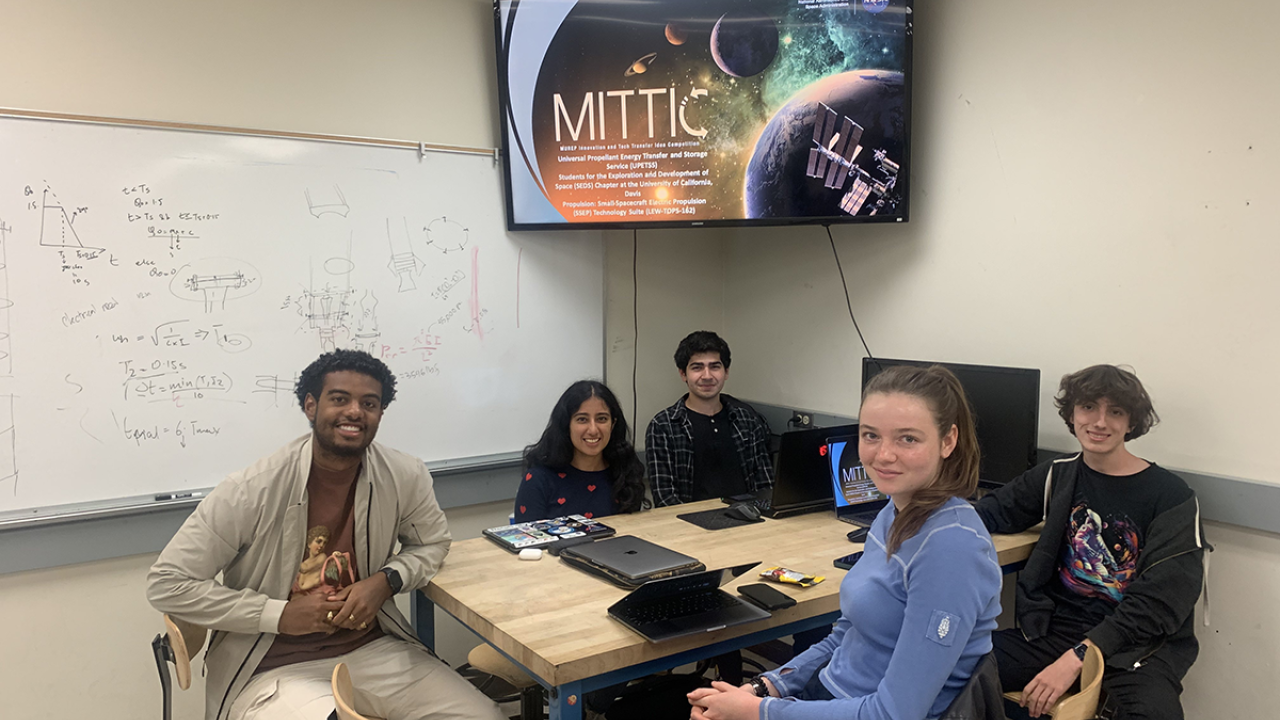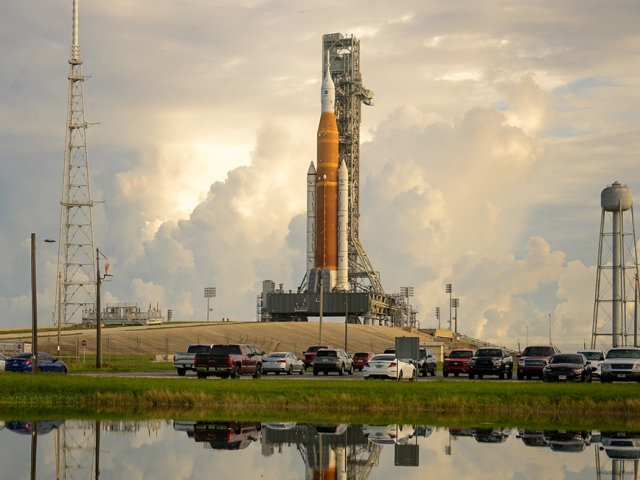
New Club Lands with Impact, Heads to NASA’s Johnson Space Center
As the newly minted co-founders of the University of California, Davis, branch of Students for the Exploration and Development of Space, or SEDS, a club that takes on space-related challenges posed by NASA and other spaceflight companies, aerospace engineering sophomores Shreya Chandra and Aidan Guerra had relatively low expectations for their very first proposal.
"We initially [sent in our project] like, 'We'll just hope for the best, prepare for the worst,'" said Chandra. "But we got picked."
Small Spacecraft, Big Impact
For the club's flagship event, Chandra, Guerra and their team accepted a challenge set by NASA's Minority University Research and Education Project, or MUREP. The request: Convert a current piece of NASA technology into a commercial venture as part of the Innovation and Tech Transfer Idea Competition, or MITTIC.
Chandra recalled a conversation with one of her mentors during her summer internship at NASA, discussing unused fuel sitting in defunct satellites still in orbit. She, Guerra and their team, including fellow aerospace engineering undergrads Yemikael Dawit, Ella Hobson and Orfeas Magoulas, had the idea to take NASA's small spacecraft electric propulsion technology suite, which includes Hall effect thrusters, a power processing unit and an anode manifold plug, and integrate it with a refuel vehicle to go into Earth's orbit, extract fuel from these satellites, and put the fuel to use by transferring it to another spacecraft.
"All of these technologies have to work together to make this new form of electric propulsion viable," said Guerra. "What's particularly useful is the technology can be implemented on small spacecraft, which our service aims to provide."
The team also developed a universal adaptor that would be installed onto all aircraft employing this service, which, in theory, would be used by public and private space agencies like NASA, SpaceX and the Department of Defense.
"We want our service to be a global service, and it's a contract service in nature," said Chandra. "We would contract out to individual companies, and, for the most part, our service would be to remove the fuels, for example, from a SpaceX satellite and put it into another SpaceX vehicle."
The team's proposal, the Universal Propellant Energy Transfer and Storage Service, or UPETSS, was selected to move on to the second phase of the competition, for which they will head to Johnson Space Center in Houston, Texas, this month to present their proposal for the chance to win $20,000 and present at the NASA Ames Research Center in the spring.
"It's really exciting – I mean, Shreya and Aidan were sitting in my office and we revised the idea only a few days beforehand," said Rich Whittle, an assistant professor of mechanical and aerospace engineering who serves as the faculty advisor to SEDS. "I always believed in them."
Great MINDS Think Alike

Chandra and Guerra also work as undergraduate researchers in Whittle's Bioastronautics and eXploration Systems Laboratory at the UC Davis Center for Space Flight Research, where they contribute to aerospace research like the development of a space ambulance or testing the reactions of the cardiovascular system upon reentry into Earth's orbit. Through working with Whittle on bioastronautics, Chandra and Guerra found a second opportunity to submit an idea to another NASA challenge: the MUREP Innovative New Designs for Space, or MINDS.
NASA MINDS asks student teams with faculty advisors to design and build prototypes for technologies to support NASA's Artemis mission, which plans to establish a long-term presence on the moon and prepare to send the first astronaut to Mars.
Their proposal builds on an idea Whittle began researching when he was working on his master's degree at Cranfield University: an inflatable habitat that would stabilize pressure and keep an astronaut alive for 24 hours should the astronaut have a catastrophic suit failure or be injured.
Whittle points out that technologies like this will be crucial for the future of Lunar exploration, with an increase in human presence on the Moon necessitating more extravehicular activity, or EVA (i.e., spacewalks), which will lead to a greater risk of accidents. This emergency system, which would be mounted onto a rover, is designed to help mitigate those risks and get the astronaut back to the habitat or to that space ambulance safely and in a timely manner.
"In Professor Whittle's lab, we're exploring bioastronautics, which is all about life in space and making sure life in space is achievable and can be done long-term," said Chandra. "Part of that is making sure that no astronaut unfortunately dies because their suit is punctured during an EVA. Safety is the number one priority, and we need to make sure astronauts are safe in space."
The project was accepted by the NASA MINDS challenge, and Chandra, Guerra and their team are set to submit a preliminary design before the end of November. If their preliminary design is accepted, the team will receive funds from NASA to build and test their projects, submitting final materials to the project this spring.
Up to the Challenge
SEDS, which currently comprises about a dozen members, joins a handful of aerospace-focused student organizations on campus. But while the other clubs may focus on the business and networking end of the aerospace industry or might have a singular project like building and launching a satellite, Chandra and Guerra hope to set SEDS apart by creating opportunities for hands-on experience in aerospace challenges.
"We really want to guide students to get involved in the realm of aerospace," said Chandra. "We want them to also be able to go to places like the Johnson Space Center and be able to have those experiences. Classes are awesome, but you figure out what you're interested in when you partake in projects beyond the classroom itself."
"I hope our experience with MITTIC and MINDS shows students at UC Davis what can be accomplished not just if you join SEDS, but also whatever you set your mind to," added Guerra, who, through this opportunity, has secured a spring internship with NASA Ames. "You can really go places."




